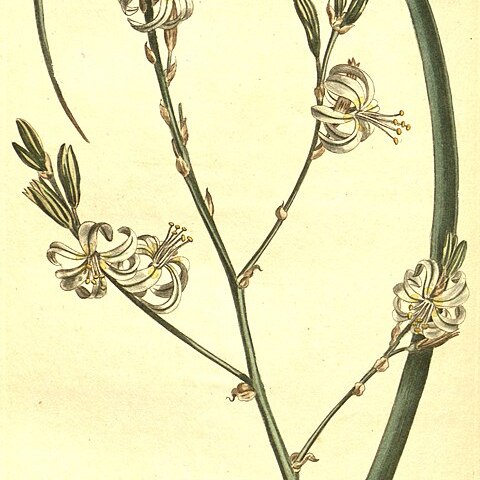Perennial rhizomatous herbs. Roots fibrous or tuberous. Leaves (in Australia) basal, linear, flat, perennial. Inflorescence a raceme or panicle, bracteate. Flowers bisexual, actinomorphic, pedicellate. Perianth segments 6, equal, free or ±connate at base, spreading above, 1-nerved. Stamens 6; anthers usually dorsifixed, versatile, dehiscing by slits, introrse; filaments retrorsely scabrid. Ovary superior, trilocular; ovules 2–16 per locule; style simple, filiform; stigma capitate. Fruit a loculicidal capsule. Seeds angled, 2–16 per locule, black.
Inflorescences with flowers racemosely or paniculately arranged on a peduncle or scape; peduncle terete, naked or rarely with a few sterile bracts in the upper part; pedicels each subtended by a floral bract, not articulated, ascending, patent or ± recurved, sometimes curving through 360°, their direction usually changing with the developmental stage of the flower and fruit.
Flowers erect to pendulous; perianth segments free, spreading or reflexed, usually white, occasionally dull yellowish (rarely pink or mauve), with a single dark central vein, the 3 outer segments slightly narrower than the 3 inner ones, caducous, the perianth base persisting below the ovary to form a small sometimes stipitate rim or cup.
Leaves rosulate, rarely ± distichous, sheathing at the base and often persisting as a sheath of fibres, or cauline and alternate; lamina linear, flat, three-angular in section or ± terete, entire, glabrous hispidulous or glandular-pubescent, outer leaves sometimes reduced to chartaceousoverlapping brown sheaths (squamae).
Geophytic herbs (sometimes suffrutescent), solitary or ± tufted, from short vertical rhizomes, acaulescent or sometimes caulescent, glabrous or glandular-pubescent.
Seeds angled, brownish or greyish, smooth or verrucose, with or without prominent ridges, with immersed yellow glands (maculate), becoming glutinous when mature.
Ovary sessile, 3-locular, globose with 2–16 ovules biseriate in each locule; style filiform, ultimately exserted, often declinate; stigma minutely penicillate.
Stamens 6, slightly shorter than the perianth segments; filaments attached to the perianth base, scabrid or retrorsely papillate; anthers versatile, introrse.
Capsule loculicidally 3-valved, globose or ± 3-lobed; testa coriaceous, smooth or tuberculate with few to many gland-tipped tubercles.
Roots numerous, fibrous, swollen and tapering or fusiform (sometimes narrowly tuberous).
Stem when present ± woody, naked or covered with old leaf bases.

